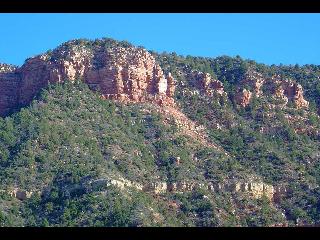 |
An
Exploration Hike
To
the Fossil Creek Area
Supai
Group Outcrop
1/18/2009
| 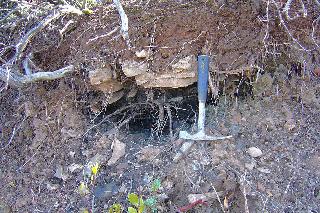 |
Updated 2/8/09
 |
Introduction
There are two primarily
localities, and several small sized outcrops of the Permian/Pennsylvanian
Supai formation on the Mogollon Rim, and several localities near
Midgley Bridge in Sedona. On the Rim, we have the Christopher
Creek uranium mine which has produced some superb plants such
as Walchia conifers, Pecopteris ferns, pyritized clams, annelid
shells, and shark coprolites. The second major locality is all
along the length of Fossil Creek near Strawberry. Here we have
found Walchia, cordiates leaves, some ferns, and of course the
rarest of rare - Permian petrified wood. This is also a unique
locality in that we have found unaltered Permian wood inside
coal balls in the shales, most of it still floats in the water.
On this expedition,
we wanted to re locate the outcrops, and survey for others to
visit on a future trip. We collected some neat plant material
and of course the icing on the cake - a small handful of petrified
wood.
|
Heading down to the Supai
Click on the Thumbnails for a larger size
 | Going down the hiking
trail toward Fossil Creek, the Supai formation outcroppings are
seen ahead as a gray band in the red Schnebly Hill Formation. |
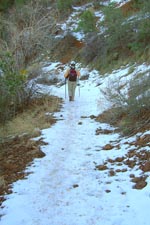 | A bit icy at the top, and
very steep. Dawn hikes ahead through the red sandstone beds of
the Schnebly hill formation, Sycamore Pass member which consists
of primarily eolian sandstones, some sandy shales, and occasional
shales. |
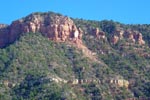 | Up ahead you can see the
limestone band below marking the Permian Fort Apache formation,
and above the Sycamore pass member of the Schnebly Hill formation
forming dramatic cliffs. |
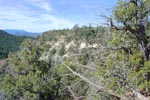 | Closing in on the gray
Supai outcrops, which continue in isolated outcrops all along
the Fossil Creek Canyon. |
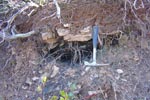 | A coal seam along the way
once we got into the Supai. It is very fissile, and breaks apart
very easily. |
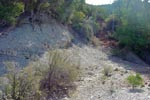 | At our coal shale locality,
the white cliffs contain carbonized remains of plants from the
Pennsylvanian / Permian boundary. There is debate what the actual
age is, however we are inclined to lean toward late Permian due
to the type of plant material found here. |
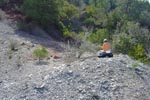 | Dawn searches for the Permian
petrified wood found here. This is the ONLY location in Arizona
we have ever found Permian wood. |
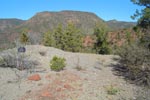 |
At
another hill side site, we found more Permian Wood, and of course
some great scenery! |
The
Fossils From the Survey trip
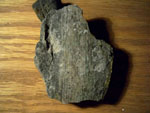 | Numerous specimens of Cordiates
leaves were found here. They are strap like leaves from a tall
primitive seed fern like tree. |
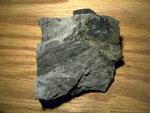 | Cordiates on left, with
part of a Calamities Suckowi impression on the right. The Calamities
are much less abundant here than in Christopher Creek. |
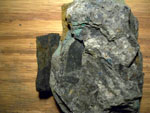 | Cordiates leaf carbonized
impression. |
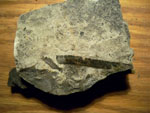 | Carbonized limb impression
from unknown plant. |
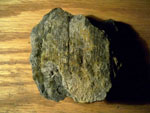 | Part of Calamities Suckowi
impression, it is about 2 inches across. |
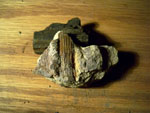 | Two calamities stems side
by side. |
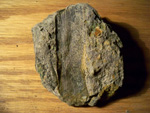 | Mold from which we pulled
a calamities limb cast from - see two pictures down. |
 | The trips most important
find for plants, a Walchia conifer frond. This was one of the
very first conifer trees to inhabit the earth. |
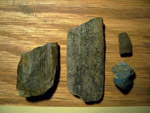 | These are all limb casts,
3 dimensional copies of the original limbs, flattened by compression
a bit. The one on the lower right is coated with azurite, a blue
mineral based on copper. |
 | We found plenty of copper
carbonates here, mainly malachite and azurite. |
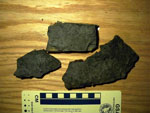 | From the coal seam along
the way on the trail, we pulled these nice specimens, about three
inches long each from the outcrop. It is very delicate, and falls
apart very easily. This is a very low grade coal. I did not find
any plant impressions in the shales above the coal however. |
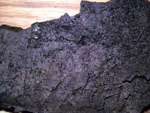 | Close up of the coal sheet
I pulled out of the bed. |
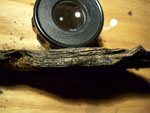 | In side view, the coal
can be seen to be very fissile and breaks apart along some thin
bedding planes. It is almost like paper in consistency. |
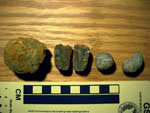 | Another amusing find was
these manganese nodules. They were very hard and were metallic
inside. They also were much heavier than any other rocks around.
We find these typically in marine sediments, but here we are
not sure why. |
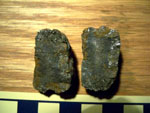 | I cracked open this manganese
nodule, and you can see the metallic interior. It feels like
a chunk of iron. |
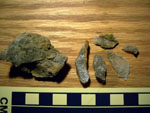 | Found at the outcrop as
well were blades of Selenite, clear gypsum crystals which formed
in the coal layers. |
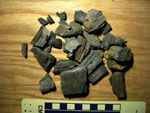 | The main prize found here
are small handfuls of Permian petrified wood! No other localities
on the Rim have we found Permian wood. It is permineralized with
silica, and contains all of its original cell structure preserved
in excellent detail. |
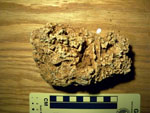 | Strangely enough, we also
found a travertine cave deposit along the trail, tertiary in
age with fossil aquatic reeds in them. This might have been the
Supai limestones dissolving and percolating through the soil
to form these deposits. The lime may have also come from the
overlaying Fort Apache Limestone. |
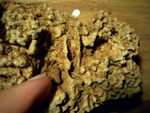 | Fossil reeds in the travertine. |
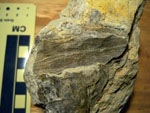 | This could be a Cordiates
leaf, but it has a central axis so its identification is in doubt. |
Some microscope images and close ups
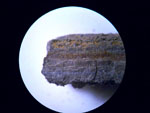 | Petrified wood with some
yellow limonite, and a layer of smoky quartz on top. |
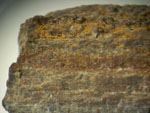 | Individual cell structures
can be seen in this higher powered zoom in the wood. |
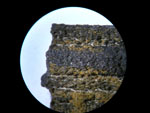 | Some of the wood had inter
layers of quartz between the wood. |
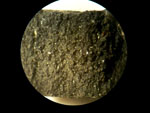 | Some of the wood was completely
crystallized in the center. |
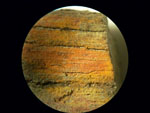 | Stunning yellow coloration
in this fine piece of Permian wood. |
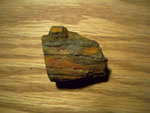 | Typical piece of Permian
wood, about 1.5 inches long. Mostly browns and yellows were the
colors. |
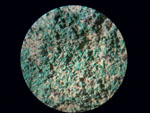 | High powered close up of
the Malachite copper mineral we found in the coal beds. |
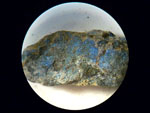 | Close up of the Azurite
copper mineral in the beds. |
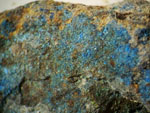 | Stunning blues in the Azurites! |
 | The Coal had small shiny
mica like flakes embedded, It fell apart in small flake like
pieces. |
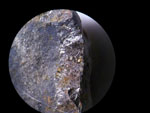 | Microscope close up of
the manganese nodule split open, showing the metallic appearance. |
|
Paleo HOME

|